I couldn't find complete instructions on how to replace my brake pads and rotors, so I decided to go ahead and make my own.
These instructions are for replacing the stock front brakes and rotors for a 1999 Audi A4 (the old style, not the 99.5 body) with ATE Powerdisc slotted rotors and Mintex Red Box pads (without the sensor). I'm assuming that you already know the proper procedure for jacking up your car, and for removing the wheels.
Note: The rear brakes are drum brakes, which are of a different construction and have a completely different method of replacement that requires a specialized piston retraction tool.
This took me about 2 hours for the first wheel, and 45 minutes for the second wheel (after I figured out what I was doing).
And of course a disclaimer: Do no attempt this if you are uncomfortable with servicing your vehicle, are not mechanically inclined, or are afraid of getting dirty.
Getting Started
Tools needed for replacing the brakes:
- Torque wrench (that measures in the 80-110lbs range)
- 7mm hex tool
- 17mm socket
- A light
Accessing the Brake Assembly
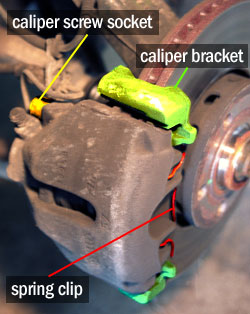
- Remove the wheel. (If you don't know how to do this, you probably want to stop now and get your brakes replaced by a mechanic instead.)
- Identify the following pieces:
- Brake Caliper: This is the bulk of the item that is clamped onto the rotor, and is what you'll be removing. The yellow-colored screw socket in the photo is part of the brake caliper.
- Caliper Bracket: This is the piece that secures the brake caliper to the axle. It is the bright green component in the photo.
- Spring Clip: This is the metal wire clip that secures the outside of the brake caliper to the caliper bracket. It is the red piece in the photo.
Remove the Spring Clip
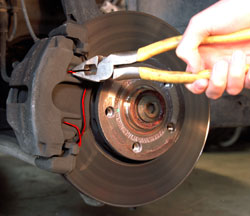
- Using a pair of pliers, pull the spring clip out of the caliper. You should grab the clip at the section where it enters the hole in the caliper, and pull out away towards the back of the car.
Remove the Brake Caliper
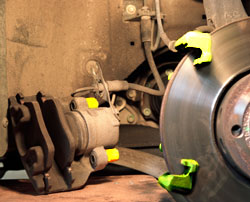
- Locate the two 7mm hex screw sockets in the back of the brake caliper (they are the yellow parts in the photos, and are made of rubber). Each has a plastic cap on it that has to be removed by prying it off with a flathead screwdriver.
- Unscrew the two hex screws.
- Remove the brake caliper from the caliper bracket. If the caliper seems to be stuck on there, try grabbing the caliper and pulling it towards you, with a little force. That should retract the piston enough to loosen its grip on the rotor and allow you to remove the caliper.
- Have some kind of platform ready to rest the caliper on. This allows you to get the caliper out of the way without disconnecting the brake line (which I'm assuming would make things quite messy).
Retract the Brake Piston
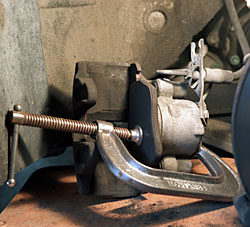
- Remove the outer brake pad but keep the inner one on, for now. You'll probably need to pry it off since the Audi pads seem to have a sticky film that glues the pad to the caliper.
- Because your new pads will be much thicker than the old pads, you'll need to push the piston back into the caliper to be able to fit the new pads onto the rotor.
- Check your brake fluid level and unscrew the cap, if necessary. Pushing the piston back will raise the fluid level so you want to keep an eye on it and make sure you catch any overflow.
- I used a C-clamp to push it back, which seemed like the easiest way to do it.
- Remove the inner pad.
Remove the Caliper Bracket & Rotor
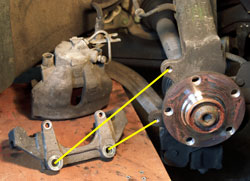
- Remove the two 17mm bolts that fasten the caliper bracket to the axle (the two yellow lines show where the bracket is attached). The bolts are extremely tight, and can be very difficult to loosen — especially if you're only using triangle stands because you have very little room for leverage. I had to use my foot, and also my jack to apply enough force to the socket wrench.
- Remove the caliper bracket.
- Once the bracket is removed, remove the rotor (if it hasn't fallen off already).
Installing the New Pads and Rotors
- Now do everything in reverse for the new components. Because I replaced both the pads and rotors at the same time, I didn't have to worry about re-bedding the existing rotors. However, I've heard that the Mintex are exact OEM replacements so re-bedding may not be necessary for you if you just replaced the stock pads.
- Install the new rotor.
- Attach the caliper bracket with the two 17mm bolts. You must tighten them to 92 ft-lbs.
- Insert the new brake pads into the brake caliper. The brake pad with the metal flanges is the inner pad that attaches directly to the piston.
- Attach the caliper to the bracket, and fasten with the two 7mm hex screws.
- Cap the screw sockets with the two plastic caps.
- Insert the spring clip back into the caliper. Putting it back in is harder than getting it out. Make sure that it's completely seated.
- Put your wheel back on.
- Repeat steps 1 through 22 for the other wheel.
- Check your brake fluid level, and bleed them if it's over the “max” level. Replace the cap.
- Test drive your car around the block slowly. The Mintex pads recommend light braking for the first 200 miles to allow them to bed properly.
Update: After putting about 400 miles on them, the pads and rotors feel fine, although the pads certainly lack that "bite" that the stock pads have. Yes, brake dust is cut down, but personally I like the stock pad "bite" better.